A good steak is, I think, one of the purest carnivorous pleasures available. A hearty roast dinner has its charms, of course, as does a slow-cooked, gelatinous stew, but neither is so absolutely, almost primitively meaty as a simple steak ? which is one of the reasons it pops up so often, in my experience, in people's fantasy final meals.
The other, I suspect, is that steak is expensive, and has the reputation of being tricky to do well at home, which means it remains a rare treat for many of us. (Rare, of course, being the only sensible way to eat steak.) But it's even pricier when you're paying someone else to cook it, and someone else to serve it, and yet more people to wash up after it ? surely it must be possible to cook a decent steak at home without an ?18,000 Josper grill?
In fact, I decided to rule out any kind of chargrilling, because in our climate for much of the year it's just not practical to suggest getting the barbecue out; this is to be a strictly kitchen-only affair. And while obviously opinion will differ as to the "perfect" cut, I've decided to go for rib-eye, on the basis that it seems to be the one favoured in the vast majority of steak recipes, from London's Hawksmoor to New York's April Bloomfield. And if it's good enough for the chefs ...
Preparation
 Wall Street Journal recipe steak. Photograph: Felicity Cloake
Wall Street Journal recipe steak. Photograph: Felicity Cloake Food science boffin (as the popular press would term him) and general genius Harold McGee reckons there are two secrets to successful steak cookery: "warm meat and frequent flips". The second I'll come to in a moment, but apparently the best way to ensure the first is to wrap the steaks in cling film then immerse them in warm water for 30?60 minutes before cooking.
A recipe from the Wall Street Journal based on tips from some of New York City's finest steakhouses recommends allowing them come to room temperature before cooking, as does Michelin-mega-chef Alain Ducasse and Hawksmoor at Home, the recipe book from the widely-worshipped London steakhouse group. I can see McGee's solution is a good one if you only get home an hour before you want to cook your steaks or if you're bound by draconian food hygiene regulations, but otherwise, allowing them to sit for two hours seems to reap exactly the same results.
Drying
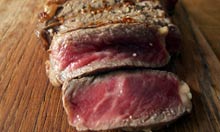 Hawksmoor recipe steak. Photograph: Felicity Cloake
Hawksmoor recipe steak. Photograph: Felicity Cloake The Wall Street Journal, Hawksmoor and Cook's Illustrated's New Best Recipe Book all recommend patting the surface of the steak dry before cooking it, which makes sense to me after my experience hair-dryering a joint of pork in the search for perfect crackling.
Hawskmoor explains that wet steak will "struggle to form a decent crust and can pick up some unpleasant boiled-meat flavours". It does seem to help a little with the initial browning process, although once the steaks have been at room temperature for a couple of hours they're already slightly drier than they would be straight from the fridge in any case.
Seasoning
 Hugh Fearnley-Whittingstall recipe steak. Photograph: Felicity Cloake
Hugh Fearnley-Whittingstall recipe steak. Photograph: Felicity Cloake In his book Kitchen Mysteries, French chemist Herv? This recommends not salting the meat "because the phenomenon of osmosis causes the juices to escape the meat when muscular fibres are cut and open" ? but Cook's Illustrated, Ducasse, the Wall Street Journal, Hawksmoor, the Leiths Meat Bible and April Bloomfield of New York's The Spotted Pig, all disagree.
Indeed, in her book A Girl and her Pig, April suggests "generously" seasoning the steaks all over with salt and letting them stand for 10 minutes ? "this will help the steaks cook evenly". Nigel Slater and Hugh Fearnley-Whittingstall both salt halfway through cooking. The Hawksmoor boys, meanwhile breezily dismiss the notion, urging the reader to season the meat "well. More than you probably think sensible. It will help build up a delicious salty crust. Some say you shouldn't season the steak until after you've cooked it. We think they're wrong."
After cooking my way through seven steaks in quick succession, I have to agree with them: salt definitely seems to help build up a crisp, savoury layer on the outside of the meat, and doesn't seem to have resulted in any significant loss of juices, possibly because of the brief cooking time involved.
Fat
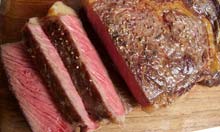 Alain Ducasse recipe steak. Photograph: Felicity Cloake
Alain Ducasse recipe steak. Photograph: Felicity Cloake Herv? This suggests you can "improve the contact and transfer of heat" by brushing the meat with oil or clarified butter before cooking ? an idea also favoured by Slater in Appetite (though "not too much, just enough to give it a good gloss"). The Wall Street Journal, Fearnley-Whittingstall and the Ginger Pig Meat Book prefer to grease the pan instead: the WSJ with flavourless canola oil, Fearnley-Whittingstall suggesting butter, dripping or lard, and the Ginger Pig going, like Slater, for olive oil.
I use dripping, but conclude that any fat is unnecessary, if not downright bad news ? although Fearnley-Whittingstall's steak sizzles as it hits the pan, it then seems to bubble away for the first 30 seconds rather than browning. There should be enough fat on a good rib-eye to keep it from sticking in any case. Bloomfield drizzles her steak with olive oil and lemon juice as it rests instead, which seems to me an infinitely better idea if you really like the flavour, though again, not strictly necessary.
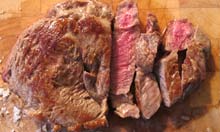 Cook's Illustrated recipe steak. Photograph: Felicity Cloake
Cook's Illustrated recipe steak. Photograph: Felicity Cloake Ducasse uses butter ? but instead of adding it to the empty pan, or brushing it on the steak, he waits until the steak is browned on all sides before introducing it. The rapidly melting butter, flavoured with crushed garlic, is then used to baste the steak as it finishes cooking. This gives it a gorgeous richness ? even the Hawksmoor book, which doesn't bother with any cooking fat in the restaurant recipe, admits that steak in butter is one of the authors' "favourite, most indulgent ways of cooking them at home". Importantly, the browning of the butter helps to impart some lovely savoury flavour to the crust along with the garlic; it's not in the pan long enough to burn. Steak is an occasional indulgence for most of us, so you may as well enjoy it to the full.
Temperature
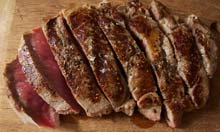 Nigel Slater recipe steak. Photograph: Felicity Cloake
Nigel Slater recipe steak. Photograph: Felicity Cloake The recipes are split broadly between those who cook the steak on a very high heat (Slater, Hawksmoor and Herv? This), and those who suggest a more moderate heat (the Ginger Pig, Fearnley-Whittingstall, the WSJ and Bloomfield). Cook's Illustrated superheats the pan, then turns the heat down after adding the steak. The argument seems to be whether charred flavours are desirable, as Hawksmoor believe, or, in Hugh's words, "a distraction from the sheer joy of eating the very best steak". Personally, I like a little bit of charring, so in general, I'd recommend getting the pan as hot as you dare before adding the steak: you shouldn't be able to hold your hand above it for more than a second before you begin to scorch.
However, Ducasse's ideas change everything again. His method depends on a really thick steak; but then, many of the recipes I try specify the steaks should be cut at least 4cm thick (Ducasse, Fearnley-Whittingstall, Cook's Illustrated, WSJ, Hawksmoor), with April Bloomfield going up to 6cm. Nigel suggests choosing one as thick as one's thumb ? I suspect his may be larger than mine, because I'm not going to bother with a steak 1.5cm thick: as Hawksmoor observes, getting the requisite contrast between charred outside and juicy interior is "very difficult with a thin piece of meat". Because the steak is so chunky, it can stand a more moderate heat for longer without overcooking, during which time "you get good caramelisation". The steaks may not be quite as black as, say, Slater's, but they do boast a very healthy crust.
Flippin' steak
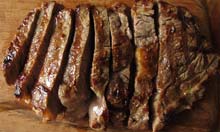 April Bloomfield recipe steak. Photograph: Felicity Cloake
April Bloomfield recipe steak. Photograph: Felicity Cloake Back to our old friend McGee, who claims that frequent flipping is the key to moist steak ? "frequent turns mean that neither side has the time either to absorb or to release large amounts of heat. The meat cooks faster, and its outer layers end up less overdone." If you're only cooking it for a couple of minutes on each side, like Slater, I'm not sure the extra juiciness is worth the sacrifice of a crust, but it makes sense with longer cooking methods, like April Bloomfield or Ducasse. It also allows you to keep a careful eye on how the cooking is coming along: steak is too precious a commodity to risk incinerating.
Nigel is also the only chef to take any notice of McGee's eminently simple suggestion of pressing down on the steak as it cooks, "to improve thermal contact". I don't find his steak at all dry, and the crust is the best of any save the Ducasse masterpiece. For quick, weeknight cooking, you can't go far wrong with his recipe (although I'd pre-salt the steak, rather than oiling it) ? but for a steak that really qualifies as perfect, read on ...
Perfect steak
For each steak
 Felicity's perfect steak. Photograph: Felicity Cloake
Felicity's perfect steak. Photograph: Felicity Cloake 1 rib-eye steak, at least 4cm thick
Coarse sea salt and freshly ground black pepper
25g butter
1 garlic clove, skin-on and crushed
1 sprig of thyme
1. Take the steaks out of the fridge 2 hours before you're planning to cook, and allow them to come to room temperature.
2. Heat a heavy-based griddle pan or frying pan over a medium-high heat. Pat the steak dry with kitchen towel and then use tongs to press the fatty edge on to the hot pan until nicely browned. Meanwhile spread a thin layer of salt and a sprinkle of coarse pepper on a plate. Put the steak on the plate, and turn to coat the steak lightly, then put it flat-side down into the pan. Cook for 90 seconds on each side, pressing down with a spatula, until both sides are well browned.
3. Add the butter, garlic and thyme to the pan and, when melted, use them to baste the steak, turning it every minute until it's done to your liking: a 4cm steak should take about 6 minutes for medium-rare, but always do it by eye.
4. Take out of the pan and leave somewhere warm to rest for 5?10 minutes, then serve.
Would steak be part of your final meal, or is it overrated? What are your must-have accompaniments (painfully hot crispy frites, steamed spinach and English mustard for me, please), and given our proudly beefy heritage, why are American steakhouses so much better than most British ones?
Source: http://www.guardian.co.uk/lifeandstyle/wordofmouth/2012/oct/25/how-to-cook-the-perfect-steak
Gigi Chao Jimmy Hoffa Ed Hochuli Opie modern family george strait how i met your mother
No comments:
Post a Comment
Note: Only a member of this blog may post a comment.